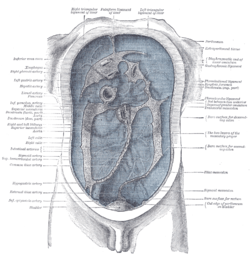Peritoneal recesses
From Wikipedia, the free encyclopedia
| Peritoneal recesses | |
|---|---|
 | |
| Diagram devised by Delépine to show the lines along which the peritoneum leaves the wall of the abdomen to invest the viscera. | |
Peritoneal recesses (or peritoneal gutters) are the spaces formed by peritoneum draping over viscera.[1]
The term refers mainly to four spaces in the abdominal cavity; the two paracolic gutters and the two paramesenteric gutters. There are other smaller recesses including those around the duodenojejunal flexure, cecum, and the sigmoid colon. These gutters are clinically important because they allow a passage for infectious fluids from different compartments of the abdomen. For example; fluid from an infected appendix can track up the right paracolic gutter to the hepatorenal recess.
The four peritoneal recesses are the:
- The left and right paracolic gutters.
- The left and right paramesenteric gutters.
See also
- Hepatorenal recess
References
- ↑ "7. Male pelvis MRI #2, midsagittal plane". Retrieved 2009-12-15.
External links
- 37:14-0100 at the SUNY Downstate Medical Center - "Abdominal Cavity: Peritoneal Gutters" page 1
- 37:14-0200 at the SUNY Downstate Medical Center - "Abdominal Cavity: Peritoneal Gutters" page 2
- 37:14-0300 at the SUNY Downstate Medical Center - "Abdominal Cavity: Peritoneal Gutters" page 3
| ||||||||||||||||||||||||||||||||||
This article is issued from Wikipedia. The text is available under the Creative Commons Attribution/Share Alike; additional terms may apply for the media files.